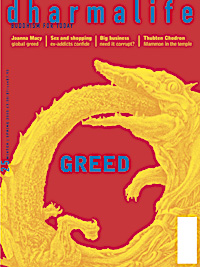Editorial: GREED
In his book Invisible Cities, Italo Calvino describes the founding of the city of Zobeide. One night many people from various nations had an identical dream in which a woman ran naked through the streets of a city. They chased her but then lost her in the maze of alleys. When they woke, they set out to find the city and, failing in that, they found each other and decided to build a city like the one in their dream. In laying out the streets each followed the course of the chase, but at the spot where they had lost the woman they arranged the walls differently, so that if the scene was repeated she would be unable to escape.
They settled in the city and waited for the scene in their dream to occur, but it never did, and eventually they forgot about the woman, the dream and their motive for building Zobeide. Others arrived who had had a similar dream and, recognising something in the city that was familiar, they adapted the streets further, adding their own snares at the point where their pursuit had failed. But the early settlers could not imagine what drew these people to Zobeide. They knew that what they had created was nothing more than a giant trap.
Zobeide might be Jerusalem, with its maze of alleys, golden domes and endless conflicts; or New York, where the Statue of Liberty offered the promise to breathe free amid its steaming tenements. But its snares echo our mind maps and neural pathways, and Zobeide is an image for all the worlds that humans create in order to possess what we desire. The untamed naked woman who stirs Calvino's dreamers signifies freedom, but what kind of liberty is it that can be possessed only when it is snared?
According to the Buddha we all want to be happy and avoid suffering, and yet we continue to act in ways that cause us to suffer. There is nothing wrong with the impulse for happiness, it is just that we seek it in the wrong places. Craving isn't just the urge for a beer or chocolate bar; it is fundamental to our whole lives. We are always desiring, always seeking the elusive thing that promises completeness, and always misunderstanding the unspoken message of our desires - that we need to satisfy our longing at its root, in our own minds. Like the citizens of Zobeide, we construct our lives in ways we believe will satisfy us through meeting our desires. But final satisfaction never arrives and in the attempt to capture it we imprison ourselves.
According to the Buddha the reason we believe that our yearning for completion can be met by, say, material wealth, is that it is underpinned by unconscious views that offer us a way of making sense of the world. These views enable us to survive and function, but only by constructing a view of the world that is at odds with Reality. As Buddhist philosophy puts it, craving grows from ignorance. So looking at craving or greed also means looking at our views.
Among the articles in this issue of Dharma Life on 'Greed' is a fascinating contrast between the Buddhist social and environmental activist Joanna Macy and Mahaprabha who runs a prestigious course at London Business School. On the surface these two represent opposite attitudes to the economic forces that are so powerful in our world. And yet both are Buddhists and passionate teachers who urge their students to find freedom by confronting their views. Mahaprabha engages his business students by asking what do they really value and how can they express that in business, rather than being bowled along by avarice and the urge to conform? Macy teaches that we can find a new relationship with the world that is based not on separateness and selfish craving, but on awareness of interconnectedness and compassion. Both are pointing a way towards freedom by seeing more clearly rather than being driven by desire.
Buddhist 'dreamers' who practise the esoteric traditions of tantra also imagine a beautiful and elusive woman: the dakini. Gazing upon her they see that she is in fact terrible - drinking blood and stamping on a corpse. But rather than recoiling in horror or attempting to tame her, they embrace her elemental wildness, and some of the most esoteric of Tibetan Buddhism's images show Buddha figures locked in sexual embrace with a dakini. Freedom, Buddhism teaches, comes when we stop trying to grasp the objects of desire and turn towards its source - in the mind.



